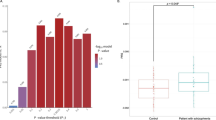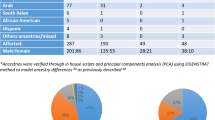Abstract
Disruptions in white matter (WM) tract structures have been implicated consistently in the pathophysiology of schizophrenia. Global WM integrity – as measured by fractional anisotropy (FA) – is highly heritable and may provide a good endophenotype for genetic studies of schizophrenia. WM abnormalities in schizophrenia are not localized to one specific brain region but instead reflect global low-level decreases in FA coupled with focal abnormalities. In this study, we sought to investigate whether functional gene sets associated with schizophrenia are also associated with WM integrity. We analyzed FA and genetic data from the Mind Research Network Clinical Imaging Consortium to study the effect of multiple oligodendrocyte gene sets on schizophrenia and WM integrity using a functional gene set analysis in 77 subjects with schizophrenia and 104 healthy controls. We found that a gene set involved in myelination was significantly associated with schizophrenia and FA. This gene set includes 17 genes that are expressed in oligodendrocytes and one neuronal gene (NRG1) that is known to regulate myelination. None of the genes within the gene set were associated with schizophrenia or FA individually, suggesting that no single gene was driving the association of the gene set. Our findings support the hypothesis that multiple genetic variants in myelination-related genes contribute to the observed correlation between schizophrenia and decreased WM integrity as measured by FA.
Similar content being viewed by others
Log in or create a free account to read this content
Gain free access to this article, as well as selected content from this journal and more on nature.com
or
References
Purcell SM, Wray NR, Stone JL et al: Common polygenic variation contributes to risk of schizophrenia and bipolar disorder. Nature 2009; 460: 748–752.
Ripke S, Sanders AR, Kendler KS et al: Genome-wide association study identifies five new schizophrenia loci. Nat Genet 2011; 43: 969–976.
Ripke S, O'Dushlaine C, Chambert K et al: Genome-wide association analysis identifies 13 new risk loci for schizophrenia. Nat Genet 2013; 45: 1150–1159.
Stefansson H, Ophoff RA, Steinberg S et al: Common variants conferring risk of schizophrenia. Nature 2009; 460: 744–747.
Goudriaan A, de Leeuw C, Ripke S et al: Specific glial functions contribute to schizophrenia susceptibility. Schizophr Bull 2014; 40: 925–935.
Friedman JI, Tang C, Carpenter D et al: Diffusion tensor imaging findings in first-episode and chronic schizophrenia patients. Am J Psychiatry 2008; 165: 1024–1032.
Liu X, Lai Y, Wang X et al: Reduced white matter integrity and cognitive deficit in never-medicated chronic schizophrenia: a diffusion tensor study using TBSS. Behav Brain Res 2013; 252: 157–163.
Nakamura K, Kawasaki Y, Takahashi T et al: Reduced white matter fractional anisotropy and clinical symptoms in schizophrenia: a voxel-based diffusion tensor imaging study. Psychiatry Res 2012; 202: 233–238.
Quan M, Lee SH, Kubicki M et al: White matter tract abnormalities between rostral middle frontal gyrus, inferior frontal gyrus and striatum in first-episode schizophrenia. Schizophr Res 2013; 145: 1–10.
Samartzis L, Dima D, Fusar-Poli P, Kyriakopoulos M : White matter alterations in early stages of schizophrenia: a systematic review of diffusion tensor imaging studies. J Neuroimaging 2013; 24: 101–110.
White T, Nelson M, Lim KO : Diffusion tensor imaging in psychiatric disorders. Top Magn Reson Imaging 2008; 19: 97–109.
Ellison-Wright I, Nathan PJ, Bullmore ET et al: Distribution of tract deficits in schizophrenia. BMC Psychiatry 2014; 14: 99.
Lee SH, Kubicki M, Asami T et al: Extensive white matter abnormalities in patients with first-episode schizophrenia: a Diffusion Tensor Iimaging (DTI) study. Schizophr Res 2013; 143: 231–238.
White T, Magnotta VA, Bockholt HJ et al: Global white matter abnormalities in schizophrenia: a multisite diffusion tensor imaging study. Schizophr Bull 2011; 37: 222–232.
Kochunov P, Glahn DC, Lancaster JL et al: Genetics of microstructure of cerebral white matter using diffusion tensor imaging. Neuroimage 2010; 53: 1109–1116.
Moran ME, Luscher ZI, McAdams H et al: Comparing fractional anisotropy in patients with childhood-onset schizophrenia, their healthy siblings, and normal volunteers through DTI. Schizophr Bull 2014; 41: 66–73.
Skudlarski P, Schretlen DJ, Thaker GK et al: Diffusion tensor imaging white matter endophenotypes in patients with schizophrenia or psychotic bipolar disorder and their relatives. Am J Psychiatry 2013; 170: 886–898.
Bertisch H, Li D, Hoptman MJ, Delisi LE : Heritability estimates for cognitive factors and brain white matter integrity as markers of schizophrenia. Am J Med Genet B Neuropsychiatr Genet 2010; 153b: 885–894.
White T, Gottesman I : Brain connectivity and gyrification as endophenotypes for schizophrenia: weight of the evidence. Curr Top Med Chem 2012; 12: 2393–2403.
Luo X, He W, Hu X, Yan R : Reversible overexpression of Bace1-cleaved neuregulin-1N-terminal fragment induces schizophrenia-like phenotypes in mice. Biol Psychiatry 2013; 76: 120–127.
Ortega MC, Bribian A, Peregrin S, Gil MT, Marin O, de Castro F : Neuregulin-1/ErbB4 signaling controls the migration of oligodendrocyte precursor cells during development. Exp Neurol 2012; 235: 610–620.
Wood JD, Bonath F, Kumar S, Ross CA, Cunliffe VT : Disrupted-in-schizophrenia 1 and neuregulin 1 are required for the specification of oligodendrocytes and neurones in the zebrafish brain. Hum Mol Genet 2009; 18: 391–404.
Voineskos AN, Felsky D, Kovacevic N et al: Oligodendrocyte genes, white matter tract integrity, and cognition in schizophrenia. Cereb Cortex 2013; 23: 2044–2057.
Gollub RL, Shoemaker JM, King MD et al: The MCIC collection: a shared repository of multi-modal, multi-site brain image data from a clinical investigation of schizophrenia. Neuroinformatics 2013; 11: 367–388.
Cheng P, Magnotta VA, Wu D, Nopoulos P et al: Evaluation of the GTRACT diffusion tensor tractography algorithm: a validation and reliability study. Neuroimage 2006; 31: 1075–1085.
Anderson CA, Pettersson FH, Clarke GM, Cardon LR, Morris AP, Zondervan KT : Data quality control in genetic case-control association studies. Nat Protoc 2010; 5: 1564–1573.
Lips ES, Cornelisse LN, Toonen RF et al: Functional gene group analysis identifies synaptic gene groups as risk factor for schizophrenia. Mol Psychiatry 2012; 17: 996–1006.
Purcell S, Neale B, Todd-Brown K et al: PLINK: a tool set for whole-genome association and population-based linkage analyses. Am J Hum Genet 2007; 81: 559–575.
Ellison-Wright I, Bullmore E : Meta-analysis of diffusion tensor imaging studies in schizophrenia. Schizophr Res 2009; 108: 3–10.
Wei Q, Kang Z, Diao F et al: No association of ZNF804A rs1344706 with white matter integrity in schizophrenia: a tract-based spatial statistics study. Neurosci Lett 2013; 532: 64–69.
Sullivan PF, Daly MJ, O'Donovan M : Genetic architectures of psychiatric disorders: the emerging picture and its implications. Nat Rev Genet 2012; 13: 537–551.
Rasetti R, Weinberger DR : Intermediate phenotypes in psychiatric disorders. Curr Opin Genet Dev 2011; 21: 340–348.
Mandl RC, Rais M, van Baal GC et al: Altered white matter connectivity in never-medicated patients with schizophrenia. Hum Brain Mapp 2013; 34: 2353–2365.
Takahashi N, Sakurai T, Davis KL, Buxbaum JD : Linking oligodendrocyte and myelin dysfunction to neurocircuitry abnormalities in schizophrenia. Progr Neurobiol 2011; 93: 13–24.
Scheel M, Prokscha T, Bayerl M, Gallinat J, Montag C : Myelination deficits in schizophrenia: evidence from diffusion tensor imaging. Brain Struct Funct 2013; 218: 151–156.
Georgieva L, Moskvina V, Peirce T et al: Convergent evidence that oligodendrocyte lineage transcription factor 2 (OLIG2) and interacting genes influence susceptibility to schizophrenia. Proc Natl Acad Sci USA 2006; 103: 12469–12474.
Roy K, Murtie JC, El-Khodor BF et al: Loss of erbB signaling in oligodendrocytes alters myelin and dopaminergic function, a potential mechanism for neuropsychiatric disorders. Proc Natl Acad Sci USA 2007; 104: 8131–8136.
Acknowledgements
This study was funded by the Netherlands Scientific Organization Grants NWO 400-08-206 and NWO/ZONW 40-00812-98-07-032 (to Posthuma). The MIND Research Network consortium is supported by the National Institute of Mental Health Grant Numbers K08 MH068540 (to White) and MH060662; the National Institute on Drug Abuse Grant Number P2ODA024196; and the National Association for Research in Schizophrenia and Affective Disorders (NARSAD) (to White). The funding agencies had no role in the design and conduct of the study. Statistical analyses were carried out on the Genetic Cluster Computer (http://www.geneticcluster.org), which is hosted by SURFsara and supported by the Netherlands Scientific Organization along with the Dutch Brain Foundation and the VU University Amsterdam.
Author information
Authors and Affiliations
Corresponding author
Ethics declarations
Competing interests
The authors declare no conflict of interest.
Additional information
Supplementary Information accompanies this paper on European Journal of Human Genetics website
Supplementary information
Rights and permissions
About this article
Cite this article
Chavarria-Siles, I., White, T., de Leeuw, C. et al. Myelination-related genes are associated with decreased white matter integrity in schizophrenia. Eur J Hum Genet 24, 381–386 (2016). https://doi.org/10.1038/ejhg.2015.120
Received:
Revised:
Accepted:
Published:
Issue date:
DOI: https://doi.org/10.1038/ejhg.2015.120
This article is cited by
-
White matter microstructure in women with acute and remitted anorexia nervosa: an exploratory neuroimaging study
Brain Imaging and Behavior (2020)
-
Candidate CSPG4 mutations and induced pluripotent stem cell modeling implicate oligodendrocyte progenitor cell dysfunction in familial schizophrenia
Molecular Psychiatry (2019)
-
White matter aberrations and age-related trajectories in patients with schizophrenia and bipolar disorder revealed by diffusion tensor imaging
Scientific Reports (2018)
-
Gene-set analysis shows association between FMRP targets and autism spectrum disorder
European Journal of Human Genetics (2017)
-
Myelination of parvalbumin interneurons: a parsimonious locus of pathophysiological convergence in schizophrenia
Molecular Psychiatry (2017)



